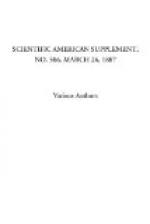May not the apparent deficiencies of the defense have been due to the fact that soldiers instead of sailors are given the control of the harbor and coast defense? Is this right? Ought they not to be organized on a naval basis? This is no new suggestion, but its importance needs emphasis.
These operations, however, convinced at least one deeply interested spectator, Lord Brassey, to the extent of calling attention “to the urgent necessity for the construction of a class of torpedo vessels capable of keeping the sea in company with an armored fleet.”
There is no one in Great Britain who takes a greater interest in the progress of the British Navy than Lord Brassey, and we take pleasure in quoting from his letter of August 23 last to the Times, in which he expressed the following opinion: “The torpedo boats ordered last year from Messrs. Thornycroft and Yarrow are excellent in their class. But their dimensions are not sufficient for sea-going vessels. We must accept a tonnage of not less than 300 tons in order to secure thorough seaworthiness and sufficient coal endurance.
“A beginning has been made in the construction of vessels of the type required. To multiply them with no stinting hand is the paramount question of the day in the department of construction. The boats attached to the Channel fleet at Milford Haven will be most valuable for harbor defense, and for that purpose they are greatly needed. Torpedo boat catchers are not less essential to the efficiency of a fleet. The gunboats attached to the Channel fleet were built for service in the rivers of China. They should be reserved for the work for which they were designed.
“We require for the fleet more fast gunboats of the Curlew and Landrail type. I trust that the next estimates for the Navy will contain an ample provision for building gun vessels of high speed.”
As torpedoes must be carried, the next point to which we would call the attention of our readers is the very rapid progress that has been made in the boats designed to carry automatic torpedoes.
A very few years ago the names of Thornycroft and Yarrow were almost alone as builders of a special type of vessel to carry them. To-day, in addition, we have Schichau, White, Herreshoff, Creusot, Thomson, and others, forming a competitive body of high speed torpedo-boat builders who are daily making new and rapid development—almost too rapid, in fact, for the military student to follow.
As new types are designed, additional speed gained, or increased seaworthiness attained, public descriptions quickly follow, and we have ourselves recorded the various advances made so fully that it will be unnecessary to enter into details here.
As late as October, 1885, an able writer said: “The two most celebrated builders of torpedo boats in the world are Thornycroft and Yarrow, in England. Each is capable of producing a first class torpedo boat, from 100 ft. to 130 ft. long, and with 10 ft. to 14 ft. beam, that will steam at the rate of from 18 knots to 22 knots per hour for 370 knots, or at the rate of 10 knots per hour for 3000 miles. A second class torpedo boat is from 40 ft. to 60 ft. long, and with 6 ft. or 8 ft. beam.




